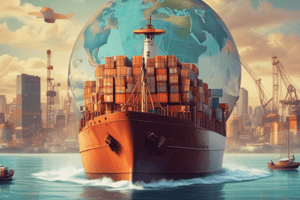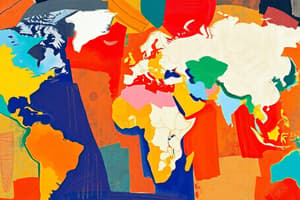Podcast
Questions and Answers
Which of the following is a potential negative impact of globalization on developing countries?
Which of the following is a potential negative impact of globalization on developing countries?
- Increased access to technology
- Improved infrastructure
- Exploitation of workers (correct)
- Higher employment rates
Globalization always leads to improved environmental conditions due to increased awareness and international cooperation.
Globalization always leads to improved environmental conditions due to increased awareness and international cooperation.
False (B)
Name one policy governments might use to manage the negative impacts of globalization.
Name one policy governments might use to manage the negative impacts of globalization.
Investing in education and training programs
Trade blocs like the European Union reduce ______ and promote economic cooperation among member countries.
Trade blocs like the European Union reduce ______ and promote economic cooperation among member countries.
Match the trade bloc with its description:
Match the trade bloc with its description:
Which factor has NOT significantly contributed to the acceleration of globalisation?
Which factor has NOT significantly contributed to the acceleration of globalisation?
Globalisation only affects the economic aspects of a country and has no impact on its culture or social structure.
Globalisation only affects the economic aspects of a country and has no impact on its culture or social structure.
Describe one potential negative impact of globalisation on local industries within a developed country.
Describe one potential negative impact of globalisation on local industries within a developed country.
The flow of __________ across borders allows businesses to invest in foreign markets, fostering globalisation.
The flow of __________ across borders allows businesses to invest in foreign markets, fostering globalisation.
Match the following aspects of globalisation with their corresponding effects:
Match the following aspects of globalisation with their corresponding effects:
Which of the following is a key characteristic of multinational companies that significantly contributes to globalisation?
Which of the following is a key characteristic of multinational companies that significantly contributes to globalisation?
Trade liberalisation, which involves countries increasing tariffs and quotas, is a major driver of globalisation.
Trade liberalisation, which involves countries increasing tariffs and quotas, is a major driver of globalisation.
Name one potential environmental disadvantage of globalisation, and briefly explain why it is an issue.
Name one potential environmental disadvantage of globalisation, and briefly explain why it is an issue.
Flashcards
Cultural Erosion
Cultural Erosion
The loss of local cultures due to dominant global brands and ideas.
Exploitation of Workers
Exploitation of Workers
Multinational companies may offer poor wages and conditions in developing countries.
Benefits of Globalization for Developing Countries
Benefits of Globalization for Developing Countries
Access to technology, improved infrastructure, and higher employment rates.
Environmental Impact of Globalization
Environmental Impact of Globalization
Signup and view all the flashcards
Trade Blocs
Trade Blocs
Signup and view all the flashcards
Globalisation
Globalisation
Signup and view all the flashcards
Trade liberalisation
Trade liberalisation
Signup and view all the flashcards
Multinational companies
Multinational companies
Signup and view all the flashcards
International trade
International trade
Signup and view all the flashcards
Economic growth
Economic growth
Signup and view all the flashcards
Job creation
Job creation
Signup and view all the flashcards
Income inequality
Income inequality
Signup and view all the flashcards
Environmental impact
Environmental impact
Signup and view all the flashcards
Study Notes
Globalization: A Summary
- Globalization is the worldwide expansion of businesses, involving international operations and the movement of goods, services, capital, and labor.
- It fosters interdependence among countries.
Causes of Globalization
- Technological Advancements: Easier global communication and transportation (e.g., internet, air travel, shipping).
- Trade Liberalization: Reduced trade barriers (tariffs, quotas) facilitating trade.
- Multinational Companies: Corporations operating globally, expanding production and services.
- Economic Policies: Free-market reforms, promoting competition and international investment.
Features of Globalization
- International Trade: Increased global exchange of goods and services.
- Labor Movement: The migration of people for work (e.g., IT, healthcare).
- Investment Flows: Easy capital movement for foreign investments.
- Cultural Exchange: Exposure to diverse cultures through media, travel, etc.
Advantages of Globalization
- Economic Growth: Increased trade, investment, and market access lead to higher growth.
- Job Creation: More employment opportunities, notably in developing countries.
- Lower Prices: Wider selection and lower costs for consumers globally.
- Innovation: Global idea and technology exchange spur innovation and productivity.
Disadvantages of Globalization
- Income Inequality: Some benefit more than others, particularly low-skilled workers.
- Environmental Impact: Negative effects on the environment due to increased production, transportation, and industrial growth.
- Cultural Erosion: Risk of local cultures losing their unique traits as global influences surge.
- Worker Exploitation: Some companies may exploit workers in developing countries.
Globalization and Developing Countries
- Potential benefits include improved infrastructure, job creation, and technological access.
- Challenges include exploitation, lack of worker protections, and dependence on global markets.
Globalization and the Environment
- Globalization's impact on the environment, involving higher carbon emissions and environmental degradation due to transportation and industrial growth globally.
Globalization and Government Policies
- Maintaining a balance between promoting globalization's benefits (e.g., growth) and managing negative impacts (e.g., inequality, environmental damage).
- Policies may involve supporting affected industries, protecting the environment, and supporting worker training.
Globalization and Trade Blocs
- Trade blocs (e.g., EU, NAFTA, ASEAN) reduce trade barriers among members and promote economic cooperation.
Future of Globalization
- Possible trends include protectionism, increased technology in trade, and how issues like climate change and pandemics reshape the interconnected world.
Studying That Suits You
Use AI to generate personalized quizzes and flashcards to suit your learning preferences.




